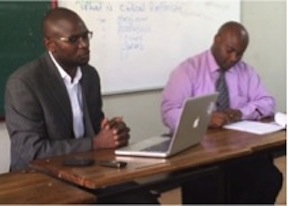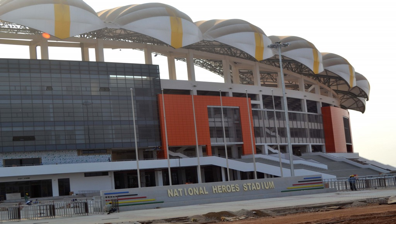 Guest Post by *Hikabwa Chipande
Guest Post by *Hikabwa Chipande
LUSAKA—On June 4, 2014, I was invited by Dr. Walima Kalusa, the University of Zambia’s History Department head, to present a fútbological paper based on my current doctoral research on the political and social history of football in Zambia (1940s-1993). The seminar on “Football and Social Change on the Northern Rhodesian Copperbelt, 1940s to 1960s” was well attended by UNZA History staff, graduate students, and other interested scholars.
I explored how urbanized African miners appropriated football from their European supervisors and, after World War II, created a new black popular culture. When colonial authorities and mining companies introduced post-War social welfare programs to appease miners and urban residents, local Africans used these structures to demand greater access to resources for organized football and other amenities in their communities. In the late 1940s and into the 1950s, Africans popularized the game on the Copperbelt and used it to build vibrant social networks and communities to replace what they left in their rural villages.
As early as 1937, the British had established the Central Native Committee, which seized control of African sport due to fears that the colonized might use football as a tool for political agitation. Despite these moves, ordinary African athletes, officials, and fans developed alternative ways of organizing and enjoying their football. For example, supporters clubs formed. These hard-core fans unexpectedly made club officials and mine managers more accountable to the people. The emerging vernacular fan culture, which no scholar has ever researched before, shows how Zambians were sometimes able to use sport to rework the application of harsh colonial policies.
Another aspect of the history of Zambian football that has eluded researchers has to do with international matches played in colonial times. As I have discovered, Copperbelt teams played in the Belgian Congo, Southern Rhodesia (Zimbabwe), and South Africa. My work illustrates how these sporting adventures, among other things, turned into incubators for Pan-Africanism because the camaraderie experienced by Zambians in these contests sharpened their sense of solidarity with fellow Africans in neighboring colonies.
Tag: Copperbelt
Guest Post by Hikabwa Chipande (@HikabwaChipande)
 LUSAKA—Zambia is mourning football radio commentator Dennis Liwewe, who died on April 22, 2014, at the age of 78.
LUSAKA—Zambia is mourning football radio commentator Dennis Liwewe, who died on April 22, 2014, at the age of 78.
Liwewe caught the soccer fever on the Copperbelt in the late 1950s and 1960s, an era that led to the emergence of great players such as Samuel “Zoom” Ndlovu, John “Ginger” Pensulo and Kenny Banda. He became the first black football commentator in the early 1960s before Zambia’s independence. Liwewe’s passionate radio broadcasts made him a household name among ordinary Zambians. At a time when there was no television, Liwewe’s enthusiastic and absorbing descriptions of matches helped popularize the game across the country.
By the mid 1970s, he was known as a prominent football announcer in neighboring countries such as Tanzania, Malawi, Zimbabwe and Botswana. When Zambia reached the final of the 1974 African Cup of Nations finals in Cairo (which Chipolopolo lost to Zaire [now DR Congo]), the Egyptian weekly magazine Al-Musawar labeled Dennis Liwewe the greatest football commentator south of the Sahara. He drew favorable comparisons with the famous Egyptian radio and television broadcaster Mohamed Latif. (Latif had played for Egypt’s national team in the 1930s, then became a referee in the 1940s, before going on to earn the nickname “Sheikh of Commentators” in the 1950s.)
From the 1960s to the early 1990s, football on the radio was synonymous with Dennis Liwewe. His emotionally loaded calls made listeners of all ages in towns and villages around the country visualize what was happening in a stadium far away. He could estimate and explain all free-kick angles, distances to the goal, and the speed of the ball in a vivid and unmistakable voice. He had that distinctive ability to carry listeners with him, bringing enjoyment to their lives and even making them proud to be modern Zambians. It was not uncommon to hear both young and old people reciting and imitating his soccer commentaries, a kind of oral literature. No wonder Zambians felt that broadcasters who did not announce like Liwewe were just not good enough.
Even after the introduction of the Mwembeshi satellites and television broadcasts in 1974, Liwewe’s radio work remained popular. It was common for soccer fans to watch live matches on television with the volume turned down to listen to Liwewe on the radio. Many fans also went to Independence Stadium in Lusaka carrying two-band radios so they would not miss Liwewe’s entertaining narration. My good friend Mtoniswa Banda reminded me that another reason why fans carried radios to the stadium was because Liwewe often exaggerated or made up his play-by-play commentary. Even when the action was dull and distant, he could narrate it as if it were only a few inches from the goalposts! Other Zambian supporters also note that Liwewe became too commercial in his old age, to the point that he demanded to be paid in cash for an interview about the history of the game.
Aside from his radio work, Liwewe was employed by the Mining Mirror as a sports reporter for the Nchanga Consolidated Mines in Chingola. Subsequently, he rose to the position of Director of Public Relations of the Zambia Consolidated Copper Mines (ZCCM) before retiring in 1985.
Dennis Liwewe’s name in Zambia evokes memories of young people in urban townships and rural villages assembling makeshift radios, repairing (or buying) new ones, putting their old batteries out in the sun hoping to get enough power to listen to their favorite football announcer. History will show that here in south-central Africa his voice, passion, and imagination were not only admired, but loved, like the beautiful game itself.
The latest Cowries and Rice podcast features Michigan State University History PhD candidate Hikabwa Decius Chipande discussing China’s stadium diplomacy in Zambia. Intriguingly, the enterprising hosts of the podcast, Winslow Robertson and Dr. Nkemjika Kalu, contacted Chipande in Lusaka after reading his “China’s Stadium Diplomacy: A Zambian Perspective” post on this blog.
In the interview (listen above), Chipande expands on his original contribution to explore several key aspects of the national and international politics of stadium construction in contemporary Zambia. Chipande shares his expert view on Zambian responses to the new arenas, inspired by Elliot Ross’s recent essay on the topic for Roads & Kingdoms, and contextualizes them within larger Chinese investments in mining and other sectors of the economy in south-central Africa.
Chipande is a recipient of the FIFA Havelange Research Scholarship for his doctoral dissertation on the social and political history of football in Zambia, 1950-1993. Reach out to him on Twitter at @HikabwaChipande.

Guest Post by *Hikabwa Chipande
“If you want to see the heart of China’s soft-power push into Africa,” writes Elliot Ross in a recent piece for Sports Illustrated’s “Roads & Kingdoms” series, “you’ll find it in the continent’s new soccer stadia.”
I am one of the many Zambians saddened that most of our national team matches are now staged at the Chinese-built Levy Mwanawasa Stadium in Ndola, an industrial town on the Copperbelt 200 miles north of the capital, Lusaka. This is not only because I live in Lusaka, where the team used to play its home games, but also because the move greatly diminishes, if not erases, the deeper significance of historic football venues.
It was in Lusaka’s then-newly constructed Independence Stadium on October 23, 1964, that the Union Jack was lowered and the new Zambian flag raised at midnight in a sumptuous ceremony attended by the Princess Royal and Kenneth Kaunda’s new cabinet. The following day, the stadium hosted the final of the Ufulu (independence) tournament. Ghana’s Black Stars, reigning African champions, beat Zambia 3-2 in front of about 18.000 spectators. From then on, almost all important international matches (as well as domestic cup finals) were played at Independence Stadium, a local example of how stadiums in postcolonial Africa, “quickly became almost sacred ground for the creation and performance of national identities” (Alegi, African Soccerscapes, p. 55).
Occasionally, Dag Hammarskjöld Stadium in Ndola hosted big matches. Constructed by the Ndola Playing Fields Association during the colonial era, this ground was rechristened in honor of the Swedish Secretary-General of the United Nations, Dag Hammarskjöld, who died in 1961 in a plane crash near Ndola. After the British colony of Northern Rhodesia became independent Zambia, the stadium was donated to the Ndola City Council. As the largest stadium in the Copperbelt, the traditional hub of football in the country, it hosted virtually every important match in the region.
In January 1986, the Zambian government bought into the idea of hosting the 1988 African Nations Cup finals. Mary Fulano, then a member of the Central Committee in charge of sport, informed the public that the government had started renovating both Independence and Dag Hammarskjöld stadiums. But in December 1986, after Dag Hammarskjöld stadium had been demolished for its planned reconstruction, Youth and Sport minister Frederick Hapunda announced that government had withdrawn its bid to host the 1988 tournament.
Copperbelt residents complained that they needed their beloved stadium, but the government kept on issuing empty promises. Surprisingly, two decades later, when an opportunity arose to build a new stadium in Ndola courtesy of China, the Zambian government opted for a completely new Levy Mwanawasa Stadium in a different area, thereby burying the rich history of Dag Hammarskjöld Stadium.
In 2012, I attended the inauguration of the Levy Mwanawasa Stadium: a 2014 World Cup qualifier between Zambia and Ghana (see my blog post about it here). The atmosphere at the venue was similar to the one described by Elliot Ross at the Estádio Nacional do Zimpeto in Maputo. Unlike the game in Maputo, however, there was no pushing and shoving at Levy Mwanawasa, thanks to plenty of available space and sound event management. But the stadium was so vast that the crowd could not sing and chant cohesively, or create the electrifying atmosphere so many of us treasure at football grounds.
The ignominuous end for Independence Stadium in Lusaka came after FIFA inspectors in 2007 declared it unsafe for international matches. As a temporary solution, the Football Association of Zambia moved internationals to Nkonkola Stadium in a small mining town on the border with the Democratic Republic of Congo. Bolstered by another Chinese loan, the Zambian government then erected a new National Heroes Stadium directly across from Independence Stadium and the graves of national team members who perished in the Gabon air crash of 1993.
The demolition of Independence Stadium prompted many people to wonder why the government chose not to renovate the hallowed ground and build the Chinese-funded stadium somewhere else in Lusaka. While younger Zambians tend to like the new sporting arenas, many older fans lament the disappearance of stadiums they associate with the stories of their personal lives, their memory, their past.
Regardless of age and status, Zambians are very much aware of “Chinese soft diplomacy.” People know that Chinese stadiums have less to do with friendship or mutual cooperation and more with gaining access to Africa’s material resources. Yet there is very little that can be done about it because the government does not consult with citizens on economic deals with China. There is criticism about Chinese firms bringing very cheap laborers to work in construction sites. But there seems to be a general feeling among the population that it is acceptable for the Chinese to build stadiums and other infrastructure in exchange for copper because the alternative is allowing Zambia’s political leaders to pocket the profits from this wealth.
—
*Hikabwa Chipande is a PhD candidate in History at Michigan State University. He is a recipient of the FIFA Havelange Research Scholarship for his doctoral dissertation on the social and political history of football in Zambia, 1950-1993. Follow him on Twitter at @HikabwaChipande